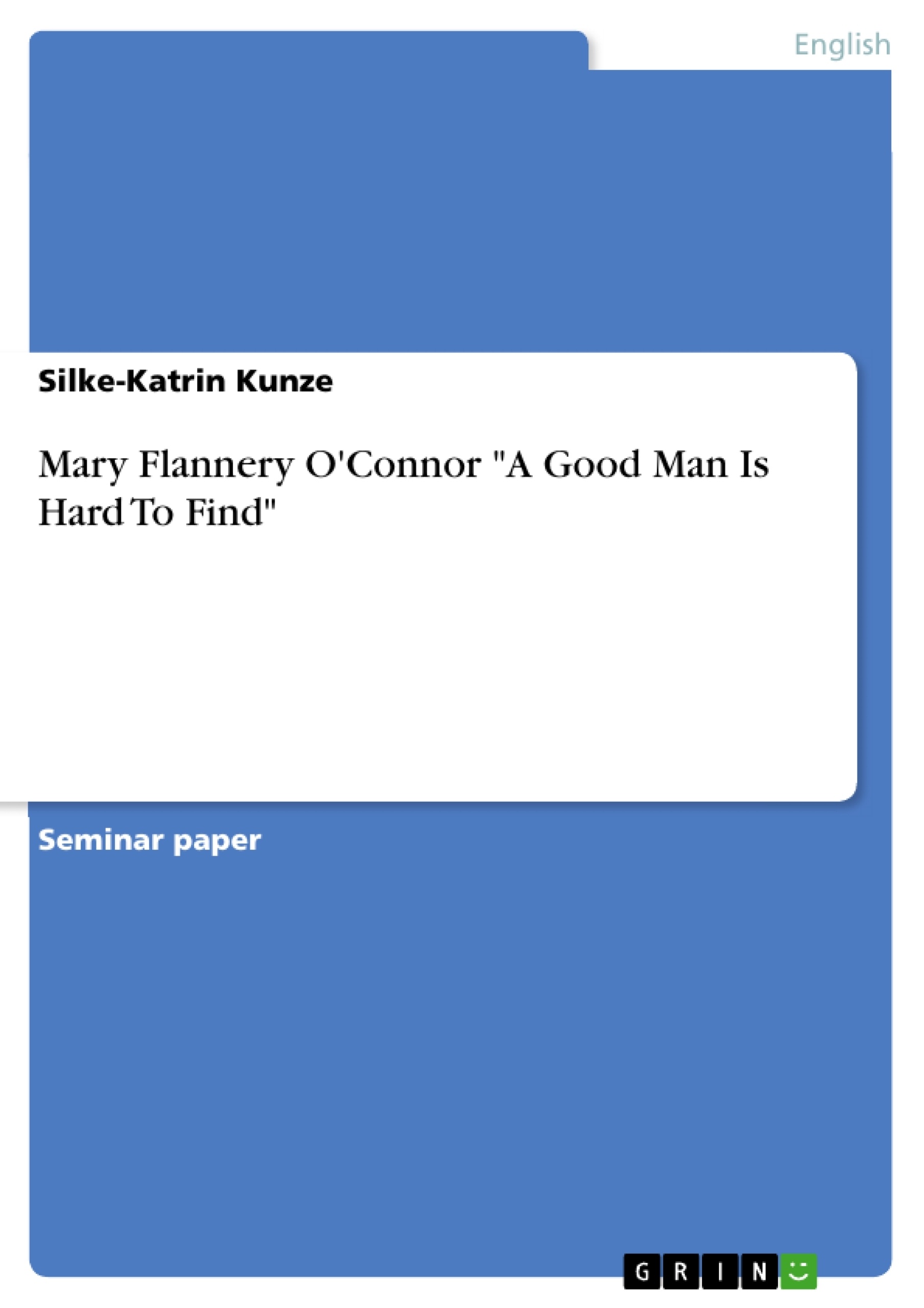Mary Flannery O’Connor’s „A Good Man Is Hard To Find“ is a shocking 20th-century-American-short-story and put under close inspection. The inspection starts with the writer herself and is followed by general facts of the short story. What is the story about and what can be concluded from it are aspects considered here. What about the point-of-view shift and the ending? Two more questions treated and finally followed by the bibliography.
Table of Contents
- Introduction
- Mary Flannery O'Connor
- "A Good Man Is Hard to Find"
- General Facts
- Content
- Conclusion
- Remarks
- Point-of-View Shift
- Ending
- Bibliography
Objectives and Key Themes
This paper aims to provide an overview of Mary Flannery O'Connor's life and work, focusing specifically on her short story "A Good Man Is Hard to Find." It examines her writing style, recurring themes, and the significance of her Southern setting.
- The interplay of faith and doubt in the face of suffering and death.
- The exploration of the grotesque and the unexpected, as tools to reveal spiritual truths.
- The use of Southern settings and characters to represent universal human experiences.
- O'Connor's unique blend of humor and violence.
- The themes of grace, redemption, and the inevitability of judgment.
Chapter Summaries
Introduction: This introductory section provides background information on the author, Mary Flannery O'Connor, including details about her life, religious beliefs, and writing career. It briefly mentions her Southern background and her use of the grotesque to explore religious themes. The introduction sets the stage for a deeper analysis of her work, particularly "A Good Man Is Hard to Find."
Mary Flannery O'Connor: This chapter delves into the life and background of Flannery O'Connor, outlining her upbringing, education, and career development. The section highlights the influence of her Catholic faith on her writing, emphasizing her preoccupation with themes such as fall, redemption, and judgment. It also describes her illness and its impact on her writing career, portraying her persistent creativity and dedication despite her health challenges. The biographical information serves to contextualize her later works and to explain the origins of her thematic concerns.
"A Good Man Is Hard to Find": This section will explore the content of O'Connor's famous short story. It will delve into the characters, plot points, and thematic elements, including the clash between the seemingly ordinary and the unexpectedly violent, and how this reflects her broader concerns with faith, morality, and the Southern experience. The analysis will encompass the story's central conflict, the ironic ending, and the lasting impact of the tale on O'Connor's legacy.
Keywords
Mary Flannery O'Connor, Southern Gothic, short stories, religion, faith, grace, redemption, judgment, grotesque, violence, humor, death, morality, mystery, the South, "A Good Man Is Hard to Find."
Frequently Asked Questions: A Good Man Is Hard to Find - Mary Flannery O'Connor
What is this document?
This document is a comprehensive language preview providing an overview of Mary Flannery O'Connor's short story, "A Good Man Is Hard to Find." It includes a table of contents, objectives and key themes, chapter summaries, and keywords. The information is intended for academic use, facilitating analysis of thematic elements within O'Connor's work.
What are the main themes explored in the analysis of "A Good Man Is Hard to Find"?
The analysis explores several key themes present in O'Connor's work, including the interplay of faith and doubt, the grotesque as a tool to reveal spiritual truths, the use of Southern settings to represent universal experiences, O'Connor's blend of humor and violence, and the overarching themes of grace, redemption, and judgment.
What aspects of Mary Flannery O'Connor's life are discussed?
The document delves into O'Connor's life, outlining her upbringing, education, career, and the profound influence of her Catholic faith on her writing. It also addresses her illness and its impact on her creative process, highlighting her persistent dedication despite health challenges. This biographical context helps to understand the origins of her thematic concerns.
What is covered in the chapter summarizing "A Good Man Is Hard to Find"?
The chapter summarizing "A Good Man Is Hard to Find" explores the story's characters, plot, and thematic elements. It analyzes the clash between the ordinary and the violent, how this reflects her broader concerns with faith, morality, and the Southern experience, the story's central conflict, ironic ending, and lasting impact on O'Connor's legacy.
What is the structure of the document?
The document is structured with a table of contents, a section outlining objectives and key themes, detailed chapter summaries (Introduction, Mary Flannery O'Connor, "A Good Man Is Hard to Find"), and a list of keywords. This structure allows for a systematic and comprehensive understanding of the text.
What are the key words associated with this analysis?
Key words associated with this analysis include: Mary Flannery O'Connor, Southern Gothic, short stories, religion, faith, grace, redemption, judgment, grotesque, violence, humor, death, morality, mystery, the South, "A Good Man Is Hard to Find."
What is the intended audience for this document?
This document is intended for academic use, supporting structured and professional analysis of thematic elements in Mary Flannery O'Connor's work. It provides a framework for in-depth study of her writing and the context surrounding it.
- Quote paper
- Silke-Katrin Kunze (Author), 1999, Mary Flannery O'Connor "A Good Man Is Hard To Find", Munich, GRIN Verlag, https://www.grin.com/document/16099



